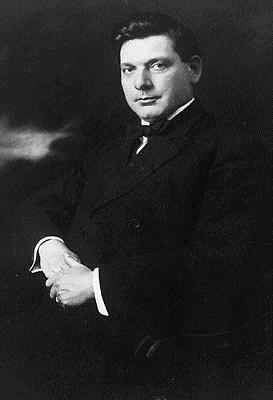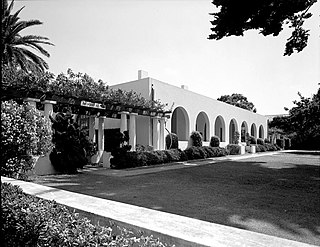
Pacific Palisades is a neighborhood in the Westside region of Los Angeles, California, situated about 20 miles (32 km) west of Downtown Los Angeles.

Frank Lloyd Wright Jr., commonly known as Lloyd Wright, was an American architect, active primarily in Los Angeles and Southern California. He was a landscape architect for various Los Angeles projects (1922–24), provided the shells for the Hollywood Bowl (1926–28), and produced the Swedenborg Memorial Chapel at Rancho Palos Verdes, California (1946–71). His name is frequently confused with that of his more famous father, Frank Lloyd Wright.

West Adams is a historic neighborhood in the South Los Angeles region of Los Angeles, California. The area is known for its large number of historic buildings, structures and notable houses and mansions.

Irving John Gill, was an American architect. He did most of his work in Southern California, especially in San Diego and Los Angeles. He is considered a pioneer of the modern movement in architecture. Twelve of his buildings throughout Southern California are listed on the National Register of Historic Places, and many others are designated as historic by local governments.

A California Historical Landmark (CHL) is a building, structure, site, or place in California that has been determined to have statewide historical landmark significance.
The western border of Santa Monica, California, is the 3-mile (4.8 km) stretch of Santa Monica Bay. On its other sides, the city is bordered by various districts of Los Angeles: the northwestern border is Pacific Palisades, the eastern border is Brentwood north of Wilshire Boulevard and West Los Angeles south of Wilshire, the northeastern border is generally San Vicente Boulevard up to the Riviera Country Club, the southwestern border is Venice Beach and the southern border is with West Los Angeles and Mar Vista.

Henry Weaver House, a California Bungalow, is in Santa Monica, California. It was built in 1910 by the Milwaukee Building Company for Henry Weaver, a Midwestern hotel developer. The house's broad roof overhang, prominent front porch and emphasis on natural colors and materials are unique features of the American Craftsman California Bungalow Style, which "fit the Southland landscape, Southland climate and Southland temperament," according to a 1910 Los Angeles Times article on the Weaver house.

Charmont Apartments is an historic five-story apartment building in Santa Monica, California which was built in 1928. Designed by architect Max Maltzman with elements of both the Mission Revival-Spanish Colonial Revival style and the Art Deco style, the Charmont was a luxurious high-rise when it was built. The blending of Spanish Colonial Revival and Art Deco elements was popular style in the 1920s and is sometimes known as "Med-Deco." The main entrance is located in a walled courtyard that features a two-tiered fountain with an intricate Moorish-patterned backsplash in polychrome tile.

Jardinette Apartments, now known as Marathon Apartments, is a four-story apartment building in Hollywood, Los Angeles, California, designed by modernist Richard Neutra. It was Neutra's first commission in the United States. In his book Key Buildings of the Twentieth Century, Richard Weston called the Jardinette Apartments "one of the first Modernist buildings in America." It has also been called "America's first multi-family, International-style building."

The original Washington Irving Branch library, located at 1802 South Arlington Avenue in Los Angeles, is listed on the National Register of Historic Places. Built in 1926, it was closed and replaced by a new branch, located at 4117 West Washington Boulevard, in 2000.

The Ebell of Los Angeles is a women-led and women-centered nonprofit housed in an historic campus in the Mid-Wilshire section of Los Angeles, California. It includes numerous performance spaces, meeting rooms, classrooms and the 1,238-seat Wilshire Ebell Theatre. The Ebell works to uplift the Los Angeles community through arts, learning and service.

Villa Bonita is an historic apartment building on Hillcrest Road in Hollywood, California. The building is located a short walk from the corner of Hollywood Boulevard and Highland Avenue, just north of Franklin Avenue and west of Highland. It was added to the National Register of Historic Places in 1986 based on its architecture.

The Town House is a large former hotel property built in 1929 on Wilshire Boulevard, adjacent to Lafayette Park in the Westlake district of Los Angeles, California. After a long career as a hotel it operates today as low income housing.

The Walter L. Dodge House in West Hollywood, California, was an architecturally significant home, designed by Irving Gill in the Early Modern style. Though the Dodge House received significant recognition from architectural experts, it was targeted for redevelopment. A long preservation effort to shield it from the wrecking ball ultimately failed, ending with complete demolition in 1970. The Dodge House was replaced by apartments.

In 1952, Frank Lloyd Wright completed his last Los Angeles building, the Anderton Court Shops, a small three-story group of shops on fashionable Rodeo Drive in the downtown section of Beverly Hills, California.

The Mission Revival style was part of an architectural movement, beginning in the late 19th century, for the revival and reinterpretation of American colonial styles. Mission Revival drew inspiration from the late 18th and early 19th century Spanish missions in California. It is sometimes termed California Mission Revival, particularly when used elsewhere, such as in New Mexico and Texas which have their own unique regional architectural styles. In Australia, the style is known as Spanish Mission.

Lincoln Place Apartment Homes is a historic apartment community owned by a subsidiary of Apartment Investment and Management Co. (Aimco). Inspired by the garden city movement, it is located at 1050 Frederick Street on a 35-acre site in the Venice community of Los Angeles, one mile east of Venice Beach. Built from 1949-1951, the property is just off Lincoln Boulevard, bound by Lake Street and Penmar Avenue with Elkgrove Avenue and Elkgrove Circle within its interior.

The La Jolla Woman's Club is a historic building in La Jolla, a neighborhood of San Diego, California. Designed and built by Irving Gill with assistance from his nephew Louis John Gill in 1914-1915, it is an important example of Gill's modern architectural style, and is listed on the National Register of Historic Places.
Albert Raymond Walker (1881-1958) was an American architect. He is primarily known for his work with Percy A. Eisen as Walker & Eisen in Los Angeles.























